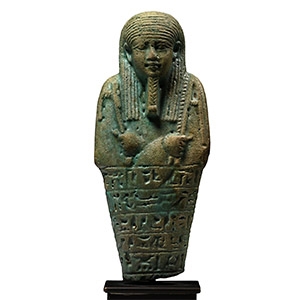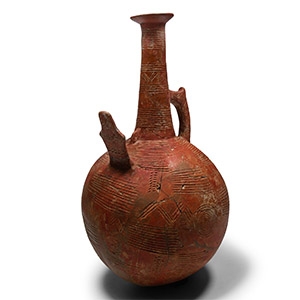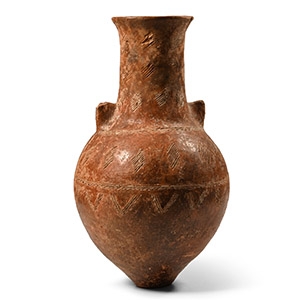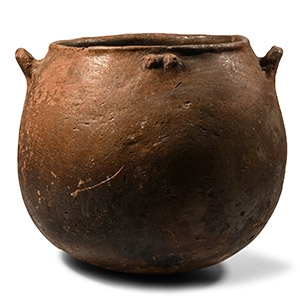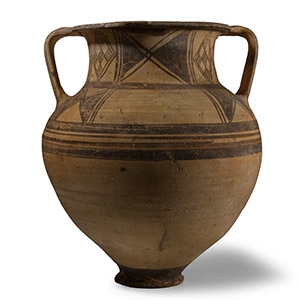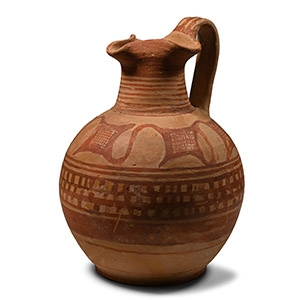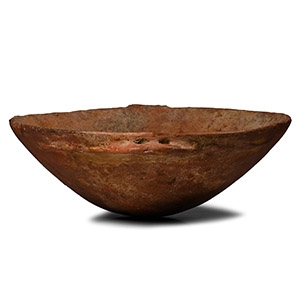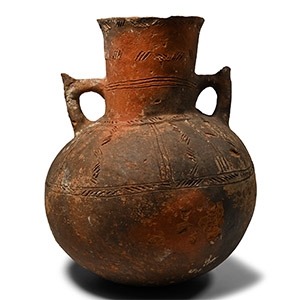Home > Auctions > 26 November - 1 December 2024
Ancient Art, Antiquities, Natural History & Coins
Probably found at the Serapeum at Saqqara in the 19th century.
From the private collection of the late Mr M.S.C., Norfolk, UK, formed 1950s-1960s.
Accompanied by an academic report by Egyptologist Paul Whelan.
Cf. Mariette, A., Le Serapeum de Memphis, Paris, 1882, pl. 19, for others of the type.
While most shabtis served as substitutes or servants of the deceased and were placed in the tomb, some, like this example, were votive objects deposited in places of great sanctity. Virtually all known Apis shabtis come from excavations in the Serapeum catacombs led by Auguste Mariette from 1850 to 1853. They all belong to activity dating to the 19th and 20th Dynasties (circa 1295-1069 BC) and were unearthed in various chambers where they had been placed as votive offerings to honour the deified Apis bulls.
Ex Y.F. collection.
Acquired in the US, 2011.
with Medusa Ancient Art, Quebec.
Private collection, Europe.
This lot has been checked against the Interpol Database of stolen works of art and is accompanied by a search certificate number no.12374-226922.
Cf. National Museums Liverpool, accession number M13871, for a similar shabti with different dedication; Janes, G., The Shabti Collections 6: A Selection from the World Museum, Liverpool, Lymm, 2016, pp.494-495, no. 258, for a similar example.
Early 20th century South East England, UK, collection.
Formerly in North American collection, 1990s.
From the collection of a London, UK, gentleman.
Accompanied by an academic report by Egyptologist Paul Whelan.
This lot has been checked against the Interpol Database of stolen works of art and is accompanied by a search certificate number no.12376-225408.
Cf. Andrews, C., Amulets of Ancient Egypt, London, 1994, item 96(e) for a less elaborate vessel in the shape of Bes; Staatliches Museum Ägyptischer Kunst, Munich (inv. no. ÄS 4868), for a similarly themed Bes-form cosmetic vessel from the New Kingdom.
This vessel's style continues that of New Kingdom and Third Intermediate Period kohl (eye paint) or unguent Bes-shaped containers, suggesting that it served as a household object rather than an item of funerary equipment.
Ex R. Liechti (1934-2010) Geneva, Switzerland, formed between 1950-1990s.
Accompanied by a copy of an old collection inventory note.
Accompanied by an academic report by Egyptologist Paul Whelan.
This lot has been checked against the Interpol Database of stolen works of art and is accompanied by a search certificate number no.12074-218220.
Cf. Raven, M.J., ‘Corn Mummies’, Oudheidkundige Mededelingen uit het Rijksmuseum van Oudheden te Leiden 63 (1982), pl. 4A, for a comparable black-painted falcon-headed coffin with yellow decoration.
This falcon-headed coffin once contained a so-called 'corn mummy' - a mummiform effigy impregnated with grain, which germinated. Such 'corn mummies' were associated with Osirian regeneration, fertility, and rebirth concepts. The falcon-headed coffin was associated with the powerful funerary deity Sokar-Osiris or Ptah-Sokar-Osiris. It seems that the original contents of this coffin were either lost or discarded and replaced with a mummified bird (falcon?). Interestingly, the most significant number of falcon-headed coffins come from Tuna el-Gebel, the site of an extensive animal mummy necropolis.
Acquired on the German art market, 1989-1995.
with The Museum Gallery, 19 Bury Place, London, WC1, UK, 1998-2003.
Property of a London based academic, 2003-present.
This lot has been checked against the Interpol Database of stolen works of art and is accompanied by a search certificate number no.12377-226045.
Cf. Leibovitch, J., 'The Statuette of an Egyptian Harper and String-instruments in Egyptian Statuary', Journal of Egyptian Archaeology 46 (1960), pp.53-59, pl. XIV, 2, for an almost identical figure in the British Museum (EA 48658).
From a collection acquired on the UK art market from various auction houses and collections mostly before 2000.
From an important Cambridgeshire estate; thence by descent.
Cf. Morris, D., The Art of Ancient Cyprus, Oxford, 1985, pls.44-45, for the type.
Red polished ware was the dominant ware of the Early Bronze Age. The clay was covered with red slip which was then burnished to produce a high point. The Philia red polished ware was characterised by incised multi-zigzag and open herring-bone bands, and also batches of multi-lines on base.
From a collection acquired on the UK art market from various auction houses and collections mostly before 2000.
From an important Cambridgeshire estate; thence by descent.
From a collection acquired on the UK art market from various auction houses and collections mostly before 2000.
From an important Cambridgeshire estate; thence by descent.
From a collection acquired on the UK art market from various auction houses and collections mostly before 2000.
From an important Cambridgeshire estate; thence by descent.
Accompanied by an academic report by Dr Raffaele D'Amato.
This lot has been checked against the Interpol Database of stolen works of art and is accompanied by search certificate number no.12313-218932.
Cf. Gjerstad, E., The Swedish Cyprus Expedition. Volume IV, Part 2. The Cypro-Geometric, Cypro-Archaic and Cypro-Classical periods, Stockholm, 1948; Brown, A.C., Catling, H.W., Ancient Cyprus, Oxford, 1975, p.44, no.7 and 45 no.5, for the type; Artzy, M., 2001, ‘A study of the Cypriote Bichrome ware: Past, present and future’, in Åström, P., (ed.), The chronology of Base-ring ware and Bichrome Wheel-made ware. Proceedings of a Colloquium held in the Royal Academy of Letters, History and Antiquities, Stockholm, May 18-19 2000, (Vitterhets Historie och Antikvitets Akademiem, Konferenser 54), Stockholm, 2001, pp.157–74; Karageorghis, V., Cipro, Crocevia del Mediterraneo Orientale, 1500-500 d.C., Milano, 2002, pp.179ff.
From a collection acquired on the UK art market from various auction houses and collections mostly before 2000.
From an important Cambridgeshire estate; thence by descent.
From a collection acquired on the UK art market from various auction houses and collections mostly before 2000.
From an important Cambridgeshire estate; thence by descent.
From a collection acquired on the UK art market from various auction houses and collections mostly before 2000.
From an important Cambridgeshire estate; thence by descent.
25 - 36 of 3419 LOTS


